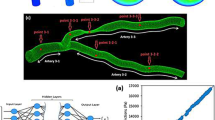Abstract
For the classification of left and right Internal Carotid Arteries (ICA) stenosis, Doppler signals have been received from the patients with coroner arteries stenosis by using 6.2–8.4 MHz linear transducer. To be able to classify the data obtained from LICA and RICA in artificial intelligence, MLP and RBF neural networks were used. The number of obstructed veins from the coroner angiography, intimal thickness, and plaque formation from the power Doppler US and resistive index values were used as the input data for the neural networks. Our findings demonstrated that 87.5% correct classification rate was obtained from MLP neural network and 80% correct classification rate was obtained from RBF neural network. MLP neural network has classified more successfully when compared with RBF neural network.
Similar content being viewed by others
REFERENCES
Steinke, W., and Kloetzsch, C., Hennereci, Carotid artery disease assessed by color Doppler flowimag-ing: Correlation with standard Doppler sonography and angiography. Ann. J. Roentgenol. 154:1061–1068, 1990.
Wagner, W. H., Treiman, R. L., Cossman, D. V., et al., The diminishing role of diagnostic arteriography in carotid artery disease: Duplex scanning as definitive preoperative study. Ann. Vasc. Surg. 5:105–110, 1991.
Blossom, G. B., Fietsam, R. J., Bassets, J. S., et al., Characteristics of cerebrovascular accidents after coronary artery bypass grafting. Ann. Surg. 58:584–589, 1992.
Beale, R., and Jackson, T., Neural Computing: AnIntroduction, Institute of Physics Publishing, Bristol, UK, 1990.
Bruzzone, L., Prieto, D. F., and Serpico, S. B., A neural-statistical approach to multitemporal and multisource remote-sensing image classification. IEEE Trans. Geosci. Remote Sensing 30:1350–1359, 1999.
Hwang, J. N., Kung, S. Y., Niranjan, M., and Principe, J. C., The past, present, and future of neural networks for signal processing. IEEE Signal Process. Mag. 14:28–48, 1997.
Grudin, M. A., On internal representation in face recognition systems. Pattern Recognit. 33(6):1161–1177, 2000.
Yung, M. H., Kreigman, D. J., and Ahuja, N., Detecting face in images: Asurvey. IEEE Trans. Pattern Anal. Mach. Int. 34(1):34–58, 2002.
Haddadnia, L., and Faez, K., Humanface recognition based on shape information and pseudo Zernike moment. Proc. 5th Int. Fall Workshop Vision, Model. Visual., Saarbrucken, Germany, November 22-24, pp. 113–118, 2000.
White, H., Learning in artificial neural networks: A statistical approach. Neural Comput. 1:425–464, 1989.
Baxt, W. G., Application of neural networks to clinical medicine. Lancet 346:1135–1138, 1995.
Mobley, B. A., Schecter, E., Moore, W. E., McKee, P. A., and Eichner, J. E., Predictions of coronary artery stenosis by artificial neural network. Artif. Intell. Med. 18:187–203, 2000.
Bishop, C. M., Neural Network for Pattern Recognition, Oxford University Press, New York, 1995.
Bezerianos, A., Papadimitrious, S., and Alexopoulos, D., Radial basis function neural networks for the characterization of heart rate variability dynamics. Artif. Intell. Med. 15:215–234, 1999.
Zhou, W., Verification of the nonparametric characteristics of backpropagation neural networks for image classification. IEEE Trans. Geo. Remote Sensing 37(2):771–779, 1999.
Yingwei, L., Sundarajan, N., and Saratchandran, P., Performance evaluation of a sequential minimal radial basis function (RBF) neural network learning algorithm. IEEE Trans. Neural Netw. 9(2):308–318, 1998.
Fredric, M. H., and Inica, K., Principles of Neurocomputing for Science and Engineering, McGraw-Hill, New York, 2001.
Ergün, U., Serhatlýo∂lu, S., Hardalaç F., and Güler Ý., Classification of carotid artery stenosis of the patients with diabetes by neural network and logistic regression. Comput. Biol. Med., 34:389–405, 2004.
McClelland, J. L., and Rumelhart, D. E., Explorations in Parallel Distributed Processing: AHandbook of Models, Programs and Exercises, MIT Press, Cambridge, MA, 1986.
Powell, M. J. D., Radial basis functions for multivariable interpolation: A review. In Cox, M. G., and Mason, J. C. (eds.), Algorithms for the Approximation of Functions and Data, Oxford University Press, New York, 1985.
Broomhead, D. S., and Lowe, D., Multivariable functional interpolation and adaptive networks. Complex Syst. 2:321–355, 1988.
Moody, J., and Darken, C. J., Fast learning in networks of locally tuned processing units. Neural Comput. 1:281–294, 1989.
Zweig, M. H., and Campbell, G., Receiver-operating characteristic (ROC) plots: A fundamental evaluation tool in clinical medicine. Clin. Chem. 39:561–577, 1993.
Author information
Authors and Affiliations
Corresponding author
Rights and permissions
About this article
Cite this article
Yýldýrým, H., Altýnsoy, H.B., Barýpçý, N. et al. Classification of the Frequency of Carotid Artery Stenosis with MLP and RBF Neural Networks in Patients with Coroner Artery Disease. Journal of Medical Systems 28, 591–601 (2004). https://doi.org/10.1023/B:JOMS.0000044961.38008.97
Issue Date:
DOI: https://doi.org/10.1023/B:JOMS.0000044961.38008.97




